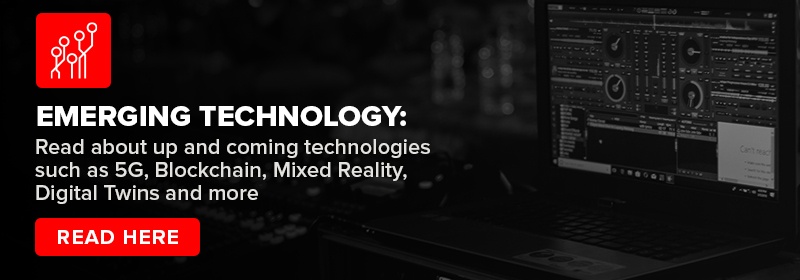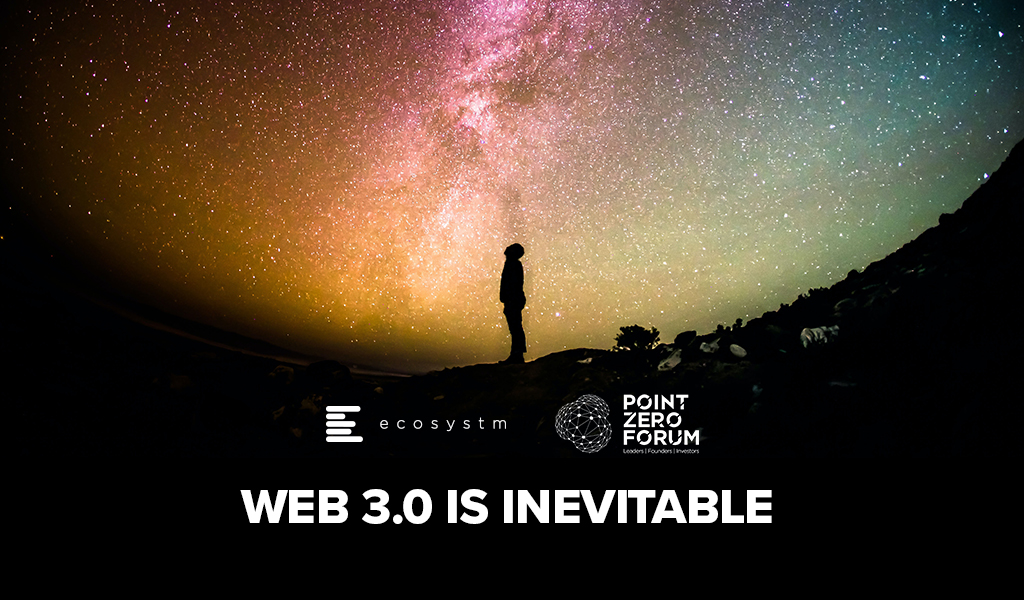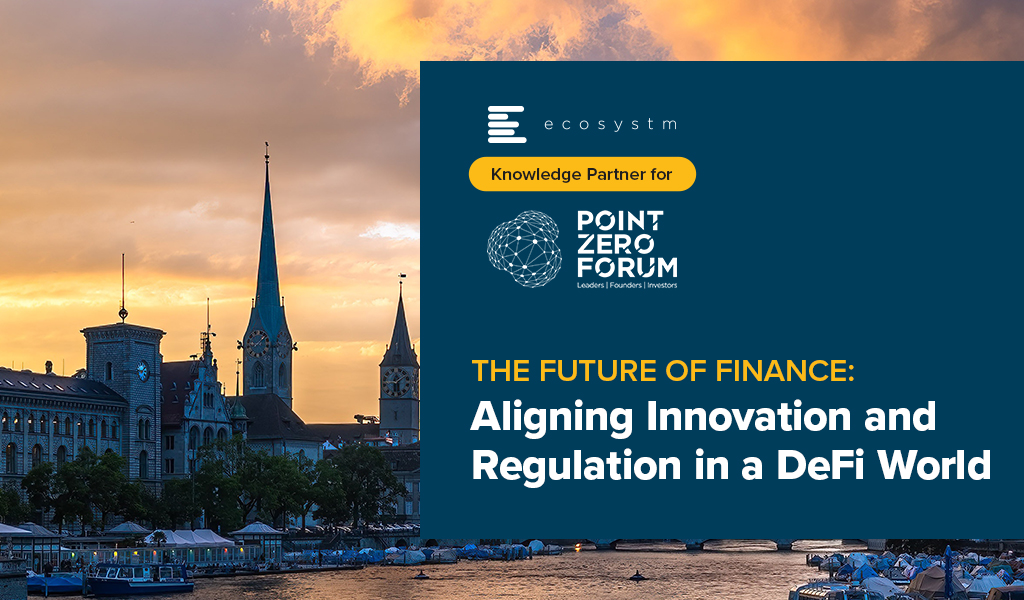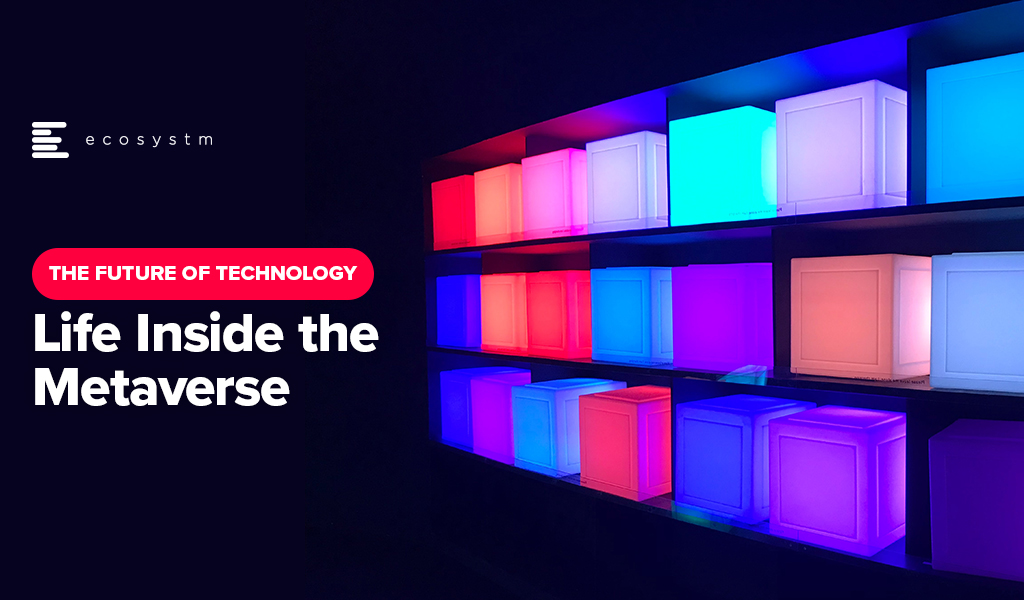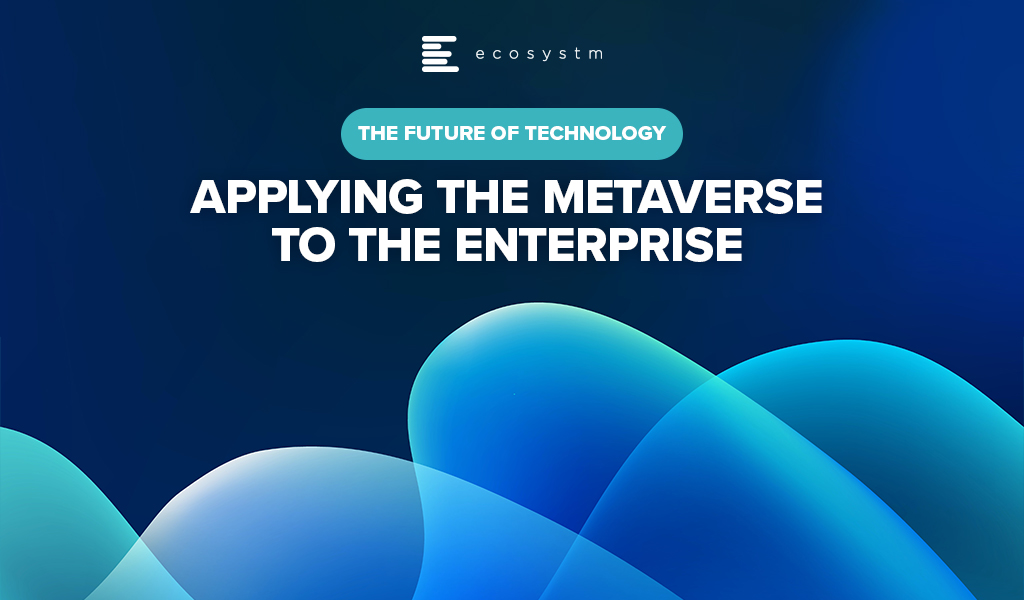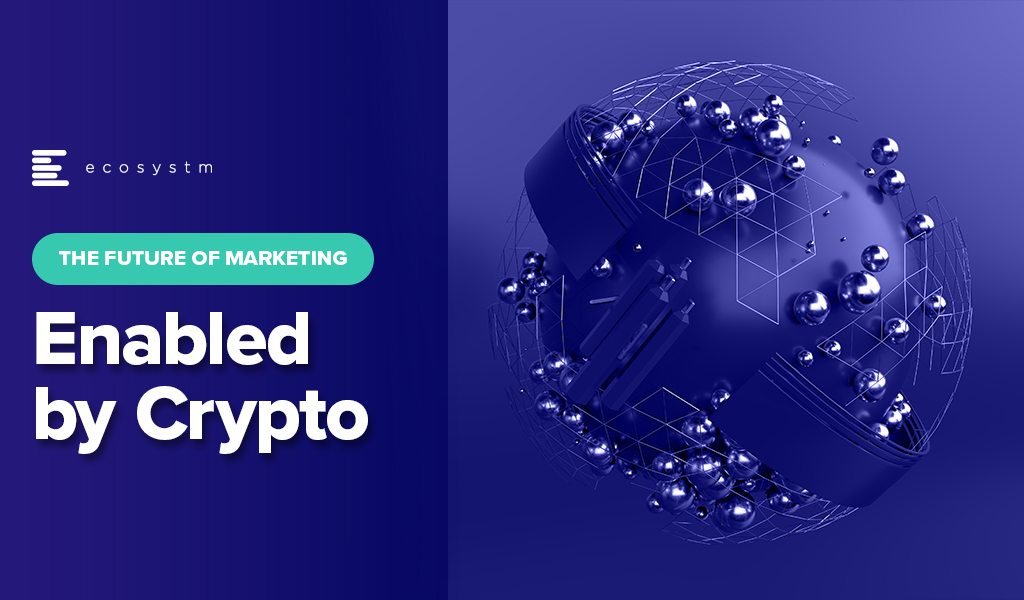The fundamentals of Web 3.0 are deeply rooted in technology that is ever-changing and continuously evolving. Web 3.0, powered by blockchains and crypto, is the Internet’s biggest technological upgrade since it became mainstream in the 1980s.
What is Web 3.0 and Why Does it Matter?
Web 1.0 (1990-early 2000s) – READ. The early Internet was characterised by an open-source protocol like HTTP, where the value accrued to the users and builders. In this era, technology companies such as Google, Yahoo and Amazon made their mark by layering on services such as search, directory listings and media publishing over an open-source infrastructure, essentially creating an online version of the offline world. The core contributors to digital media were mainly journalists, writers and reporters who reproduced pieces of their print content in a digital format. There was very little censorship during this period and the information was available mainly as databases.
Web 2.0 (early 2000-today) – READ & WRITE. This phase witnessed a wave of tech advancement, upgrades to servers, faster Internet speeds, development of complex APIs, algorithms and code to create peer-to-peer opportunities, user-generated content and social networking. Services such as Facebook and Twitter began monetisation of the increased user base through digital advertising. The years 2007-2012 saw a mobile revolution with Apple providing users with their first iPhone in 2007 and opened doors to third-party apps and builders. Facebook’s mobile pivot in 2012 amplified user social connectivity tremendously.
The tech architecture for Web 2.0 is built on a client-server protocol, where users are the clients, contributing content and the companies control the servers. The core functionality of the early Internet which was open for anyone to use and build on, has now transformed where the authority rests in the hands of the few. The rise of the creator economy is dependent on the frameworks developed by centralised companies. Software and hardware upgrades and renunciation of data and privacy rights by users to platforms have further accelerated centralisation of power. The Web 2.0 ecosystem now has a monopolistic culture where the companies decide who can participate, in what capacity, and how much value to share with stakeholders. Consumers do not have any ownership of their data or control over how it gets used; while creators give up rights to their content and do not have the ability to export their fanbase out from the platforms they have used, to interact with their communities. There is no incentive alignment between corporations and networks, and the users have no say in the platforms’ economics and governance. Web 2.0 is an Internet era built on ‘rented land’ where users don’t own anything.
Web 3.0 (2020 onwards) – READ, WRITE and OWN. Web 3.0 is a new computing platform, a paradigm shift towards a more democratised Internet, which is owned by the users and builders who create and transfer value in a trustless and decentralised way, facilitated through tokens. It is re-engineering the Internet’s open protocol and leveraging its architecture to benefit people rather than corporations.
The Core Components of Web 3.0
In order to understand the importance of Web 3.0 as technological innovation, it is essential to learn about its core components – tokens and blockchains.
Tokens are pieces of code that are used to transact over a blockchain and provide a record of digital ownership. They can be fungible and non-fungible. Fungible tokens are interchangeable (fiat currency, cryptocurrencies like Bitcoin). Non-Fungible tokens are unique, i.e no two tokens are alike (such as pieces of art).
The genesis of the blockchain architecture was developed by a pseudonymous individual named Satoshi Nakamoto in 2009, who developed a peer-to-peer electronic cash system called Bitcoin (the blockchain), that uses its native token (BTC) to transact over its network. Blockchain is a decentralised distributed ledger system, where transactions are executed and recorded in a series of immutable blocks on an interconnected network of nodes (computers).
Blockchains can be imagined as supercomputers that process thousands of transactions in exchange for incentives or tokens that accrue to miners and validators as rewards. Tokens are a new digital asset class that is increasingly seen as a store of value (Bitcoin), means of exchange (Ethereum, Solana and alternative cryptocurrencies), social currency (Rally.io) and several other use cases that offer utility and monetisation abilities to creators, entertainers and artists.
Future Value Drivers
Since 2020, we have seen the growth of cryptocurrencies and blockchain adoption by institutions and retail investors due to the decoupling of crypto into various value drivers like Decentralised Finance (DeFi), Non Fungible Tokens (NFTs) and Decentralised Autonomous Organisations (DAOs).
DeFi. DeFi refers to a financial system that runs on blockchain technology, and uses smart contracts that replace the need for traditional financial (TradFi) businesses to act as intermediaries. Core functions such as lending, borrowing. and transacting takes place seamlessly without the need for banks to execute the transactions. DeFi runs on code, a set of rules that are predefined on smart contracts. Users of the decentralised protocol own the network and participate in the rewards through token distribution. Tokens are distributed as incentives to users who are contributors to the network. There are strong differences between DeFi and TradiFi on trust, transparency, identity and access.
NFTs. NFTs are a record of ownership of digital assets on a blockchain. Technological advancements to the Bitcoin Blockchain genesis architecture and the introduction of smart contracts to blockchains such as Ethereum enabled a new use case of tradeable programmable tokens to emerge in the crypto landscape.
NFTs have been transformational to digital asset ownership and saw exponential growth in user adoption in 2020. A key milestone event in the history of NFTs is the USD 69 million sale of ‘Everydays: the first 5000 days’, by digital artist Beeple at an art auction organised by Christie’s in March 2020. Transaction volumes have now surpassed nearly USD 13 billion.
NFT represents anything digital that’s unique (non-fungible), has value, can be traded and its ownership secured on a blockchain. NFTs most commonly represent digital art, but they can be digital wearables, in-game virtual objects, a contract deed attached to a property, a domain name, or even a piece of writing such as this insight! For the first time, it is possible to exchange value between two trustless individuals anywhere in the world without them needing to disclose their identities or establish any contact and have asset ownership transferred and recorded on a blockchain.
DAO. A DAO is a community that is created and managed by its members who band together to achieve a common objective. Web 3.0 has enabled a dynamic shift in behavioural economics which is drawing people to it. The shift can be described as triabism at times but has been fascinating. The ongoing pandemic made more people spend time online and in the Metaverse, connect with others and also create. That happy place is called a DAO, where humans meet to share, connect, and drive value in a digital world known as the Metaverse.
Here are some ways that a DAO differs from a corporate. Companies are governed by a hierarchical system whereas DAOs are run like cooperatives in a flat structure. Company management takes decisions whereas DAO members vote on proposals to take collective decisions. Companies hire talent that meets certain criteria whereas anyone can join a DAO if they hold the DAO tokens/NFT or get invited to join the community. Companies compensate their employees with salaries whereas DAOs reward contributors with tokens.
The Future of a Decentralised Economy
Web 3.0 is transforming the economics of the creative, media and entertainment industry by changing the dynamics of how value gets created and distributed. It is an Internet that works for stakeholders who own it and create value for themselves. The shift from Web 2.0 to Web 3.0 is taking place more rapidly than the previous evolution of the Internet. The power dynamics and value generation are fundamentally changing how we view the Internet.
Web 3.0 is inevitable!

It’s been a while since I lived in Zurich. It was about this time of year when I first visited the city that I instantly fell in love with. Beautiful blue skies and if you’re lucky enough, you can see the snow-capped mountains from Lake Zurich. It’s hard not to be instantly drawn to this small city of approximately 1.4 million people, which punches well above its weight class. One out of every eleven jobs in Switzerland is in Zurich. The financial sector generates around a quarter of the city’s economic output and provides approximately 59,000 full time equivalent jobs – accounting for 16% of all employment in the city.
Between 21-23 June, Zurich will also be home to the Point Zero Forum – an exclusive invite-only, in-person gathering of select global leaders, founders and investors with the purpose of developing new ideas on emerging concepts such as decentralised finance (DeFi), Web 3.0, embedded finance and sustainable finance; driving investment activity; and bringing together public and private sector leaders to brainstorm on regulatory requirements.
The Future of DeFi
Zug is a little canton outside of Zurich and is famously known as “Crypto Valley”. When I lived in Zurich, Zug was the home of many of the country’s leading hedge funds as Zug’s low tax, business friendly environment and fantastic quality of life attracted many of the world’s leading fund managers and companies. Today the same can be said about crypto companies setting up shop in Zug. And crypto ecosystems are expanding exponentially.
However, with the increase in the global adoption of cryptocurrency, what role will the regulators play in aligning regulation without stifling innovation? How can Crypto Valley and Singapore play a role in defining the role regulation will play in a DeFi world?
DeFi is moving fast and we are seeing an explosion of new ideas and positive outcomes. So, what can we expect from all of this? Well, that is what I will discuss with a group of regulators and industry players in a round table discussion on How an Adaptive and Centralised Regulatory Approach can Shape a Protected Future of Finance at the Point Zero Forum. We will explore the role of regulators in a fast-moving industry that has recently seen some horror stories and how industry participants are willing to work with regulators to meet in the middle to build an exciting and sometimes unpredictable future. How do we regulate something in the future? I am personally looking forward to the knowledge sharing.
For the industry to strive and innovate, we need both regulators and industry players to work together and agree to a working framework that helps deliver innovation and growth by creating new technology and jobs. But we also need to keep an eye out on the increasing number of scams in the industry. It is true to say that we have seen our fair share of them in recent months. The total collapse of TerraUSD and Luna and the collapse of the wider crypto market that saw an estimated loss of USD 500 billion has really spooked global markets.
So is cryptocurrency here for good and will it be widely adopted globally? How will regulators see the recent collapse of Luna and view regulations moving forward? We have reached an interesting point with cryptocurrencies and digital assets in general. Is it time to reflect on the current market or should we push forward and try to find a workable middle ground?
Let’s find out. Watch this space for my follow-up post after the Point Zero Forum event!

While the concept of the Metaverse can be complex and confusing, it is not hard to imagine the benefits it will bring to an enterprise. In Applying the Metaverse to the Enterprise, I talked about how a Metaverse is nothing more than real life in digital form. Let us now look at what life inside a Metaverse will look like.
The 4 Key Capabilities of the Metaverse
A Metaverse will allow for individual validation within a corporate environment through the association of four key capabilities:
Digital Built Environment. The digital built environment is the representation of the physical surroundings that provide the setting for human activity. A Metaverse provides a powerful, online, 3-D and 4-D representation of the physical workplace.
Interaction. Inhabitants of a Metaverse are known as avatars or residents. They can be representatives of staff or customers; and personalise an individuals’ interaction with the information being sought.
Navigation. Natural search occurs when the capability exists to spatially move an avatar through a digital environment. Today, the power of spatial search is self-evident and highlighted through applications such as Google Maps.
Collaboration. Social and information networks are created when two or more parties can openly and freely exchange information. They are also the basis of contemporary, decentralised digital economics (e.g., blockchain). Organisations are increasingly moving to incorporate emerging social technologies into traditional collaboration environments for decades.
The choice of a Metaverse would seem obvious for large organisations looking to move away from a process view of information. Building or construction analogies are already used to deal with the abstraction of information within their complex physical environments. It is, for example, a key principle of enterprise architecture. As a result, the decision to utilise a metaverse as a channel is ultimately not a big call.
The Metaverse will Require a Paradigm Shift
As a presentation layer, a Metaverse makes navigation and discovery easier and more intuitive. Adopting this new approach would allow a completely social and familiar way to interact with information. It would provide organisational benefits beyond the current capabilities of traditional data and process-driven environments and become the catalyst for major differences in the treatment of enterprise information. The interactive context of a Metaverse will also require differences in the way information is expressed.
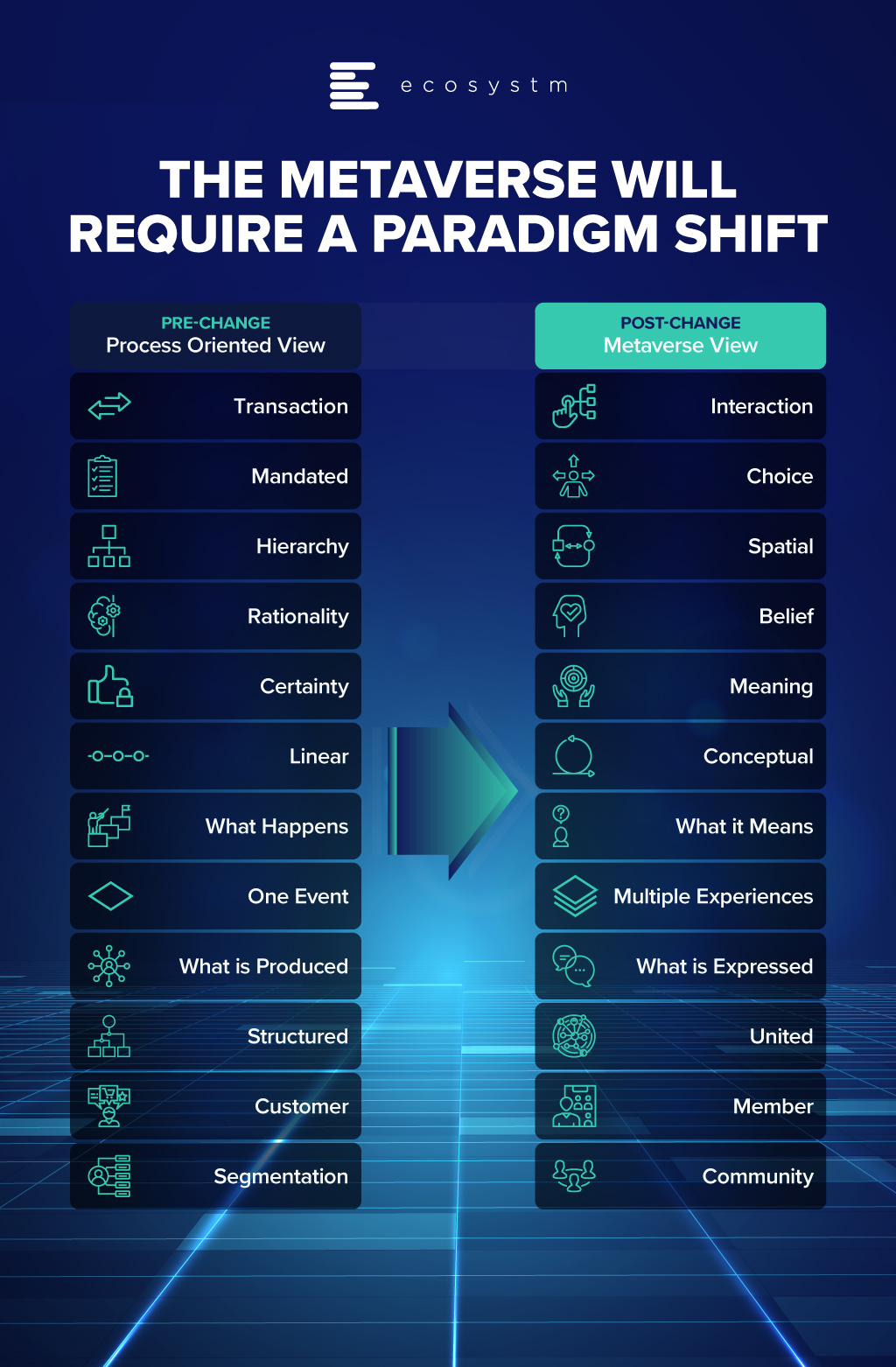
Although the tech industry is strewn with concepts of “exchange” and “collaboration”, such terms are really actions that occur after an audience has engaged with the content. The Metaverse approach potentially addresses this challenge by first getting users comfortable with their environment before encouraging them to interact in it with others. Using these differences as key drivers, the creation of a Metaverse can focus on delivering a platform for personalised information discovery, specific to the responsibilities and opportunities for individuals within an organisation or broader ecosystem.
This is just one example of the Metaverse and enterprise. There are many others. For example, think about fully integrated asset management platforms used by retail property groups or airport corporations. The Metaverse will now allow these organisations to commercialise their full physical retail assets in a digital metaverse by offering tenants both a physical store and a digital store. Or even offer the digital space to a whole new portfolio of different tenants. The commercial upside of such models is significant and sure to drive investment.
Overcoming the challenges of introducing a new information delivery channel seems like a difficult transformation choice today. Ultimately, this is the transition choice of Web 3.0. It is one that acknowledges that existing process-oriented channels will fail to meet the primary drivers and demands underpinning the growth of the new Web 3.0 world: individualism, personalisation, and decentralisation.
Yes, virtual reality environments are a super-appealing channel because of their immediate visual gratification, but behind that façade, the monetisation of physical, commercial data and the continual rise of infonomics is what it is all about.

The Metaverse is the latest in a long line of social computing capabilities to have emerged over the past 20 years. Each of the technologies has brought with it key changes to customer and staff behaviours and influenced the portfolios of traditional corporate business systems. In the modern world, Enterprise Resource Planning (ERP), websites and their Content Management Systems (CMS,) and Customer Relationship Management (CRM) are no longer sufficient. Forward-looking enterprises can’t ignore the need to assess the key impacts of next-generation social computing platforms as they strive to embrace a Web 3.0 presence through optimised internets, digital distribution channels and numerous online marketplaces. The Metaverse is deserving of some consideration in this assessment.
The Need for Perspective in Chaos
Attracting and retaining top talent is a key goal for any large enterprise because people drive the ultimate success of every organisation. In the more buoyant economies, more work is driving the need for more workers! Competition for resources is intense and most industries, including Government, are now experiencing the challenges inherent to a tight labour market. This in turn is continuing to fan the flames of digital and cultural transformation programs as CEOs and their leadership teams reposition for relevance.
I recall one such transformation program in a client organisation from a few years ago. It started, as they do, with a sweeping internal review of customer relationships, service delivery performances, product portfolios, service capabilities, competitors, organisational culture, and skills. It was to spearhead a program of transformation underpinned by a new labour force, unified in its desire to meet every need of their clients. Its brave and remarkable outcome was identifying and accepting that the role of the “individual” inside the organisation would be the number one catalyst for future success in dealing with everything outside it: employee experience driving the customer experience.
On reflection, it is not hard to see how individuals lose their way inside large organisations. Over time, as staff numbers increase to support growth in customers and projects, complexity starts to bleed across the business and into the culture. At a time when better communication and more access to information has become more important than ever, these attributes have become even harder to find. And not just any information; information that is relevant to the individual and specific to their role; that is critical to providing perspective within the chaos. Enter the Metaverse.
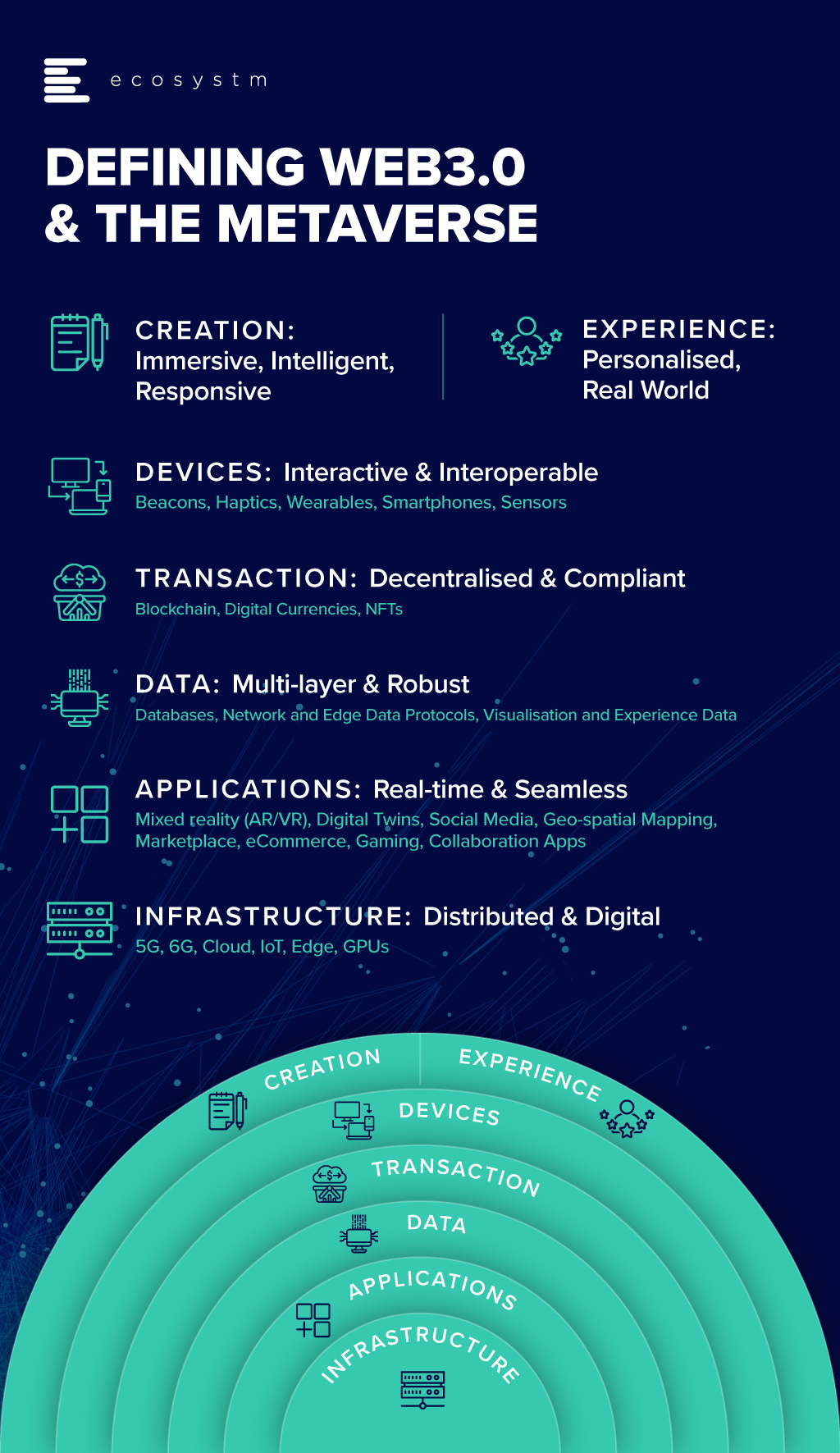
What is the Metaverse for an Enterprise?
The Metaverse is everything we simultaneously love and loathe about technology. But what an opportunity! The ability to reinvent. To embrace. To transform. But also, a gilded Parthenon of extraversion and Silicon Valley excess. Yet another mirror of some contrived reality. Another step away from a simpler, more wholesome time.
Let’s all calm down. When applied to the enterprise, a Metaverse is nothing more than real life in digital form. It provides a platform capable of:
- Developing a virtual representation of an organisation, its structures, and objectives,
- Visually representing complex concepts to allow contextual interpretation by an audience,
- Encouraging excitement and enjoyment from experiencing old information in new ways,
- Giving the user a sense that it’s all about them (literally placing them at the centre), and
- Delivering an environment that provides the opportunity to integrate with existing and emerging tools.
In the context of that transformation program from many years ago, in most large organisations the information that employees need to feel valued and add value does exist but is largely inaccessible or resides in fragmented islands of data. This is because, forged through decades of compliance, the organisational view of information within companies is process-oriented. Most databases are unpopular. Most intranets are over-populated and under-utilised.
Achieving a desired cultural outcome (that recognises the individual as the number one catalyst for future success) necessitates that this process-oriented model changes to a more individual, highly contextualised, and information-driven view. Maybe even a unified collaborative data hub with a unique presentation layer. Maybe even a Metaverse!
In my next insight, I’ll share a glimpse of how life inside a Metaverse will look like for an enterprise.

In the last decade, blockchain technology and crypto have been laying the foundations for an alternative reality in which humans interact and organise themselves without the mediation of a third party. Cryptocurrencies are almost a USD 2 trillion asset today and billions of dollars are being traded globally without the need of a bank or intermediary, with transactions secured on blockchains. Non-fungible tokens (NFTs) – currently valued at over USD 500 million – fuelled the democratisation of the art world and provided a proof-of-concept that crypto enables wider communities to transact pseudonymously.
The discovery, storytelling, evangelism, transfer of ownership in exchange for monetary value, are taking place seamlessly in the decentralised world, without a single dollar being spent on advertising. There is no central owner or authority directing this phenomenon.
Read on to find out more about:
- How crypto is causing a Marketing revolution
- The ways corporates, consumers and content creators are leveraging it
- The growth in Decentralised Marketing (DeMar)
- The NFT use case for brands
- Brands in Web 3.0 today
Download The Future of Marketing: Enabled by Crypto as a PDF
